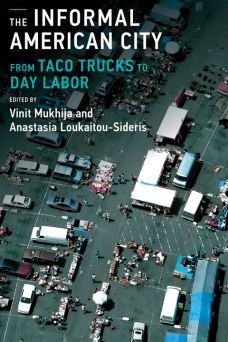The Informal American City

The Informal American City is a response to both increasing informal urbanism in the United States and the simplistic notion that informality is only a negative or marginal aspect of urbanization, to be discouraged or ignored. The book, edited by two urban planning professors at the University of California, Los Angeles, gathers case studies of different American cities and different informal activities: urban farms, resourceful housing strategies, etc. Each case study explores the nature of US informal urbanism and suggests planning and policy responses to it.
One misconception addressed in the book is that only the poor are involved in informal economic activity. Of course, the US urban poor do engage in informal strategies to get by; the chapter on homelessness amidst Atlantic City’s casinos documents people sleeping in bus terminals, obtaining food from tourists, and cashing out the small amounts left in slot machines. But the diversity of American informal activities can be seen in tax evasion by the wealthy, to give one example. Another is the garage sale. There are millions of these household clear-outs each year, largely in US suburbs, and participating in a garage sale is argued to be as much a recreational activity as an economic one. Positive aspects of this unregulated activity include its contribution to community life and promotion of recycled goods.
Another obvious misconception is that economic informality is mainly relevant in low-income countries, as a strategy to source income or shelter. The cases explored in the book show that the informal economy is alive and well in American cities. This extends to a Los Angeles family fitting a second housing unit, or “granny flat”, onto its land to house in-laws, as well as a low-income household along the Texas/Mexico border building its own house in a colonia subdivision.
The editors point out that lessons can be applied to high-income countries from low-income ones, which have more experience of addressing informality on a policy level. This raises interesting possibilities for comparison. Would informal settler organizations’ experience of community upgrading in Mumbai be relevant to Texan colonia households seeking to upgrade their self-built homes? Do conventions of common property in Bangkok apply to contested public space, such as streets and sidewalks, in Florida? Or, to reverse the direction: could Portland’s flexible regulatory regime for food carts influence policies regarding street food vendors in Nairobi? Do the day labour worker centres in some American cities have any commonalities with labour organizing among home-based workers in Dhaka’s garment industry?
Regardless of any broader applicability, The Informal American City is guided by “the belief that the early twenty-first-century city cannot be fully understood without documenting and comprehending the landscapes of informality”. It addresses the insufficiency of research on US informal urbanism and explores how urban space can be used in an effective and inclusive way.
Further reading:
Donald Brown, Gordon McGranahan and David Dodman (2014), “Urban economic informality and building a more inclusive, resilient and green economy”, Human Settlements working paper, International Institute for Environment and Development, London, available at http://pubs.iied.org/10722IIED.html?k=urban%20informality.
Guillaume Iyenda (2005), “Street enterprises, urban livelihoods and poverty in Kinshasa”, Environment and Urbanization Vol 17, No 2, pages 55–67, available at http://eau.sagepub.com/content/17/2/55.abstract.
SPARC and KRVIA (2010), Re-interpreting, Re-imagining, Re-developing Dharavi, Society for the Promotion of Area Resource Centres and Kamla Raheja Vidyanidhi Institute for Architecture and Environmental Studies, Mumbai, 81 pages, available at http://www.sdinet.org/media/upload/documents/ReDharavi.pdf.
Book note prepared by Christine Ro
Search the Book notes database
Our Book notes database contains details and summaries of all the publications included in Book notes since 1993 - with details on how to obtain/download.
Use the search form above, or visit the Book notes landing page for more options and latest content.
For a searchable database for papers in Environment and Urbanization, go to http://eau.sagepub.com/

